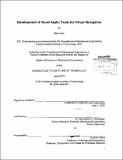Development of novel haptic tools for virtual navigation
Author(s)
Sim, Diana
DownloadFull printable version (17.83Mb)
Other Contributors
Massachusetts Institute of Technology. Department of Mechanical Engineering.
Advisor
Mandayam A. Srinivasan.
Terms of use
Metadata
Show full item recordAbstract
Learning how to navigate a real space using haptic virtual environments can be challenging. One major issue is the inefficient rate of exploration due to the single point interface of haptic devices. The use of haptic fields such as repulsive and attractive force fields was studied to determine their ability to enable global sensing to improve haptic navigation. Repulsive Force Fields for Global Haptic Sensing: Repulsive force fields were designed to help users understand their environments more quickly through global sensing. Two experiments were conducted using repulsive force fields to provide information about indoor and outdoor spaces. In both experiments, repulsive force fields were found to be usable but not more effective in teaching the user about the environment than no force field. Attractive Force Fields for Global Haptic Sensing Applied to Route Guidance: Attractive force fields were studied in the context of providing route guidance. Several haptic guides were designed and evaluated in a developmental experiment. The most promising haptic guide was selected and compared to conventional alternatives (using no guide and an audio guide) in a main experiment to determine its ability to effectively aid route learning. The haptic guide fared poorly in the initial main experiment and was re-designed. Following this, a final main experiment was conducted with ten subjects. The results suggest that the haptic guide is, in fact, an effective tool for route learning.
Description
Thesis (S.M.)--Massachusetts Institute of Technology, Dept. of Mechanical Engineering, 2013. Cataloged from PDF version of thesis. Includes bibliographical references (p. 75-79).
Date issued
2013Department
Massachusetts Institute of Technology. Department of Mechanical EngineeringPublisher
Massachusetts Institute of Technology
Keywords
Mechanical Engineering.